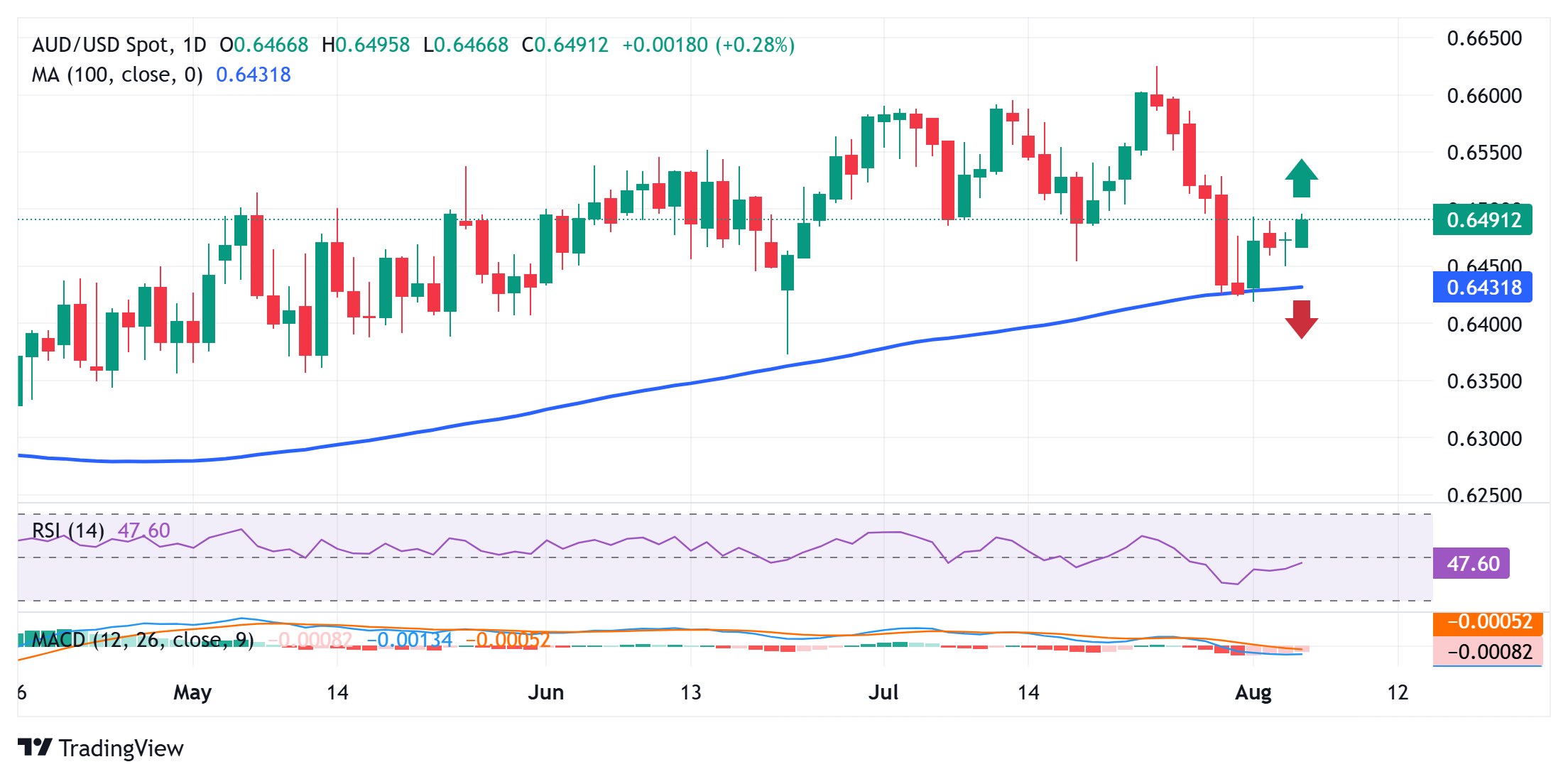
- AUD/USD attracts some follow-through buying on Wednesday amid subdued USD demand.
- September Fed rate cut bets and a positive risk tone undermine the safe-haven Greenback.
- Trade uncertainties might cap the Aussie ahead of the crucial RBA policy meeting next week.
The AUD/USD pair advances to a one-week top during the first half of the European session, with bulls now awaiting a sustained move beyond the 0.6500 psychological mark before positioning for any further gains. The US Dollar (USD) continues with its struggle to attract any meaningful buyers in the wake of the growing acceptance that the Federal Reserve (Fed) will cut interest rates at the September policy meeting. This, along with a positive risk tone, undermines the safe-haven Greenback and acts as a tailwind for the risk-sensitive Aussie.
Traders ramped up their bets that the US central bank will resume its rate-cutting cycle soon following the release of a weaker-than-expected US Nonfarm Payrolls report on Friday, which pointed to a sharp deterioration in labor market conditions. Adding to this, the Institute for Supply Management (ISM) reported on Tuesday that its Services Purchasing Managers’ Index (PMI) slipped to 50.1 in July from 50.8 in the previous month. Additional details showed that the Employment Index ticked lower to 46.4 from 47.2, and the New Orders Index deflated to 50.3 during the reported month from 51.3 in June. Moreover, data released by the US Census Bureau and Bureau of Economic Analysis showed that the trade deficit narrowed more than expected, to $60.2 billion in June from $71.7 billion in the previous month, amid a dip in imports following a tariff-fueled spike earlier in the year.
This underscores the ongoing drag on the economy amid the uncertainty over US President Donald Trump’s erratic trade policies. In the latest development, Trump announced that new tariffs on the semiconductor and pharmaceutical sectors will be unveiled within the next week or so. Furthermore, Trump warned of imposing a 35% tariff on the European Union (EU) if it fails to fulfill commitments. Meanwhile, the Trump administration has already imposed levies on imports of cars and auto parts as well as steel and aluminum. This keeps investors on edge, which, along with rising Fed rate cut bets and fears about the central bank’s independence, continues to act as a headwind for the buck. However, the Reserve Bank of Australia’s (RBA) dovish tilt might hold back traders from placing aggressive bullish bets around the Australian Dollar (AUD) and cap the AUD/USD pair.
Hence, the focus remains glued to the RBA monetary policy meeting next week. Heading into the key central bank event, the latest Chinese inflation figures on Saturday might influence the China-proxy Aussie during the opening hours next week. This, along with the latest US inflation figures, should provide some meaningful impetus to the AUD/USD pair and determine the near-term trajectory. In the meantime, speeches from influential FOMC members will be looked upon to grab short-term trading opportunities later during the North American session on Wednesday in the absence of any relevant US macro data. Nevertheless, the aforementioned fundamental backdrop warrants caution before positioning for any further appreciation.
AUD/USD daily chart

Technical outlook
Oscillators on the daily chart are yet to confirm a bullish bias, suggesting that a sustained strength and acceptance above the 0.6500 mark is needed to back the case for additional gains. The AUD/USD pair might then climb to the next relevant hurdle near the 0.6550 area. The momentum could extend further towards the 0.6585 zone, or the year-to-date peak touched in July. Some follow-through buying beyond the 0.6600 mark could lift spot prices to the 0.6640 region en route to the 0.6680 region, or November 2024 swing high, and the 0.6700 round figure.
On the flip side, the daily trough, around the 0.6465 region, could offer some support to the AUD/USD pair ahead of the 100-day Simple Moving Average (SMA), currently pegged near the 0.6430 region. Some follow-through selling below the 0.6420-0.6415 area, or over a one-month low touched last Friday, will be seen as a fresh trigger for bearish traders. The subsequent fall could drag spot prices below the 0.6400 round figure, towards the June monthly swing low, around the 0.6375-0.6370 region. A convincing break below the latter should pave the way for the resumption of the recent sharp corrective decline from the YTD peak.
Information on these pages contains forward-looking statements that involve risks and uncertainties. Markets and instruments profiled on this page are for informational purposes only and should not in any way come across as a recommendation to buy or sell in these assets. You should do your own thorough research before making any investment decisions. FXStreet does not in any way guarantee that this information is free from mistakes, errors, or material misstatements. It also does not guarantee that this information is of a timely nature. Investing in Open Markets involves a great deal of risk, including the loss of all or a portion of your investment, as well as emotional distress. All risks, losses and costs associated with investing, including total loss of principal, are your responsibility. The views and opinions expressed in this article are those of the authors and do not necessarily reflect the official policy or position of FXStreet nor its advertisers. The author will not be held responsible for information that is found at the end of links posted on this page.
If not otherwise explicitly mentioned in the body of the article, at the time of writing, the author has no position in any stock mentioned in this article and no business relationship with any company mentioned. The author has not received compensation for writing this article, other than from FXStreet.
FXStreet and the author do not provide personalized recommendations. The author makes no representations as to the accuracy, completeness, or suitability of this information. FXStreet and the author will not be liable for any errors, omissions or any losses, injuries or damages arising from this information and its display or use. Errors and omissions excepted.
The author and FXStreet are not registered investment advisors and nothing in this article is intended to be investment advice.







